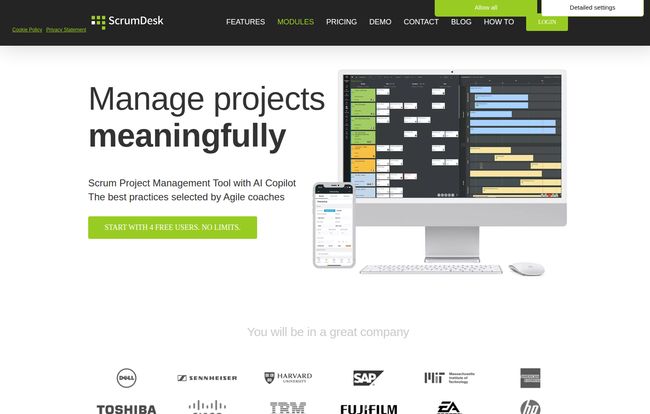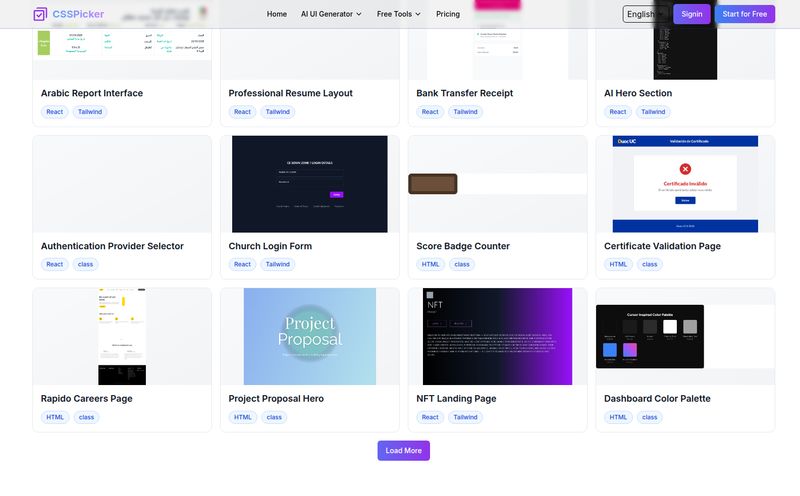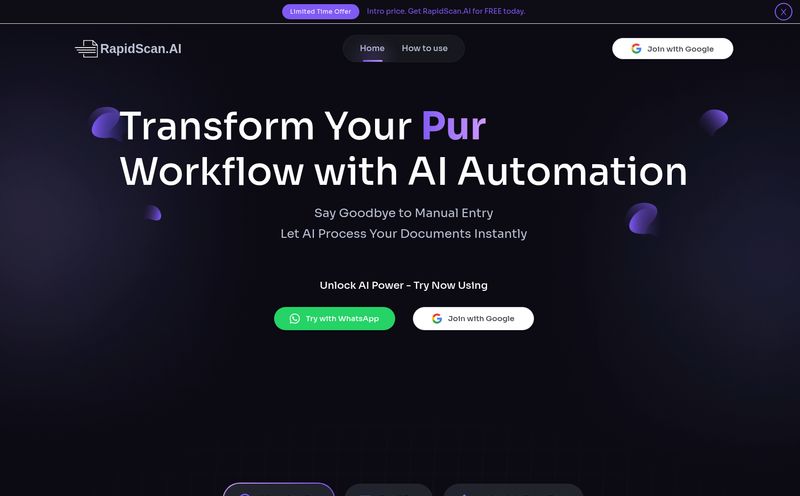If you've been in the digital or tech space for more than a week, you've probably tried a dozen different project management tools. I know I have. My digital graveyard is filled with the ghosts of Trello boards, abandoned Asana tasks, and Jira projects that became too complicated for their own good. It's a never-ending quest for the perfect platform—the one that just gets how your team works.
Every so often, though, you stumble upon a tool that’s been quietly doing its thing, building a solid reputation without all the Silicon Valley hype. That’s the feeling I get with ScrumDesk. With 17 years in the game and names like IBM, Harvard, and SAP on their customer list, they’re clearly not the new kid on the block. So, why haven’t more people been shouting about them?
Today, I’m putting my SEO blogger hat on to give you the real, no-fluff rundown of ScrumDesk. Is it just another tool, or is it the agile powerhouse your team has been waiting for?
What Exactly is ScrumDesk Anyway?
At its heart, ScrumDesk is an online project management tool specifically built for agile teams. If your world revolves around sprints, stand-ups, backlogs, and retrospectives, you're in the right place. It’s designed to help you “manage projects meaningfully,” which I love. It’s not just about ticking off boxes; it’s about understanding the why behind the work. It supports both Scrum and Kanban methodologies, so it's flexible enough for different agile workflows, from structured sprints to continuous flow.
Think of it as the grown-up version of your first Kanban board. It has all the visual, drag-and-drop simplicity you'd expect, but with layers of strategic depth underneath.
The Features That Actually Matter for Agile Teams
A feature list is just a list until you see how it actually helps you get stuff done. ScrumDesk has a lot to offer, but a few things really stood out to me as being genuinely useful for day-to-day agile mangement.
More Than Just a To-Do List: Scrum and Kanban Boards
Obviously, this is the core of the tool. You get robust Scrum and Kanban boards that are clean and intuitive. For Scrum teams, you can plan sprints, manage your backlog, and track progress with burn-down charts. For Kanban folks, you can visualize your workflow, set WIP (Work in Progress) limits, and keep the work flowing smoothly. It’s the operational hub where all the action happens.
Connecting the Dots with OKRs and User Story Mapping
This is where ScrumDesk starts to pull away from the pack. The built-in Objectives & Key Results (OKR) management is a huge win. How many times have we worked on features without a clear line of sight to the company's goals? OKRs bridge that gap, aligning the daily grind of the development team with the big-picture business strategy. You can literally link your tasks and stories back to the objectives they serve.
Then there’s User Story Mapping. Instead of a flat, one-dimensional backlog that scrolls forever, you can build a visual map of the user's experience. This is a game-changer for product managers and UX designers, helping everyone understand how features fit together to create a cohesive whole.
The AI Copilot: Buzzword or Genuinely Helpful?
Okay, I'm naturally skeptical when I see "AI" slapped onto a product. It's the marketing buzzword of the decade. But with ScrumDesk, the AI Copilot seems to have some practical applications. It's designed to help you with things like refining user stories, identifying potential roadblocks, and summarizing progress. It won't do your job for you, but it acts like a smart assistant, a second pair of eyes to help you stay on track. I'm cautiously optimistic about this—it shows they're thinking about the future of project management.

Visit ScrumDesk
Learning from Mistakes with Retrospectives and Root Cause Analysis
For me, this is the mark of a truly mature agile tool. Agile isn't just about shipping fast; it's about continuously improving. ScrumDesk has built-in tools for retrospectives, making it easy to facilitate discussions on what went well and what didn’t. Even better, it includes features for Root Cause Analysis, like the 5 Whys or a fishbone diagram. This helps teams dig past the surface-level symptoms and find the real source of a problem, preventing it from happening again. That’s a powerful feedback loop right there in your project tool.
Let's Talk Money: The ScrumDesk Pricing Model
Alright, this is probably my favorite part. The pricing is so refreshingly straightforward and generous that it almost feels too good to be true. For so long, the industry standard has been per-user-per-month from user number one. ScrumDesk throws that out the window.
Here's the breakdown:
| Plan | Price | Key Details |
|---|---|---|
| FREE | $0 / user / month | For teams up to 4 users. You get all features, no limits. This isn't a crippled free plan; it's the full experience. |
| Start | $9 / month | This is for the 5th user and up. The first 4 users are still free. Includes fundamental features. |
| Professional | $18 / month | Again, this is for the 5th user and up. The first 4 remain free. You get all features, including the AI capabilities. |
That FREE plan is incredible. A small startup, a side-project team, or even a small agency can get started with a professional-grade, full-featured agile tool for absolutely nothing. That’s how you build a loyal user base. The pricing for larger teams is also very competitive. It's an interesting model that really supports teams as they grow.
Does It Play Well with Others? ScrumDesk Integrations
No tool is an island, and ScrumDesk knows this. It integrates with the usual suspects you'd need for a development workflow: Jira, Trello, GitLab, Bitbucket, and Redmine. This is great for teams who need to sync repositories or migrate from another platform.
But the one I want to call out is the Slack integration. Being able to manage tasks, get updates, and collaborate on your work without constantly switching contexts and leaving your primary communication hub? That’s a massive productivity boost. It’s a must-have feature in my book, and ScrumDesk delivers on it.
The Good, The Bad, and My Honest Take
So, what’s the final verdict? No tool is perfect, but ScrumDesk gets a lot right.
The Good Stuff:
- The insanely generous free plan for up to 4 users is the best I’ve seen in a while. It’s the real deal.
- It's a true agile tool, built from the ground up with features like OKRs and user story mapping that support agile principles, not just task tracking.
- The focus on continuous improvement via retrospectives and root cause analysis is a sign of a well-thought-out product.
The Not-So-Good Stuff:
- There might be a bit of a learning curve. This isn't a simple to-do list app. To get the most out of features like OKRs and story mapping, your team will need to invest some time to learn the ropes. That’s not a bad thing, just a reality.
- The pricing jump from 4 to 5 users, while fair, is a budget point that scaling teams need to plan for.
Frequently Asked Questions about ScrumDesk
Is ScrumDesk really free to use?
Yes, it's completely free forever for teams with up to 4 users. This plan includes all features, so you're not missing out on the core experience. It's one of their biggest selling points.
Can I migrate my projects from a tool like Jira or Trello?
Yes, ScrumDesk offers integrations with both Jira and Trello, which is designed to help teams sync data or migrate their work over. You won't have to start from scratch.
Is this tool only for software development teams?
While it was designed with software development in mind, any team practicing agile can benefit. Marketing, operations, and HR teams that use Scrum or Kanban frameworks will find the features just as useful.
What does the AI Copilot actually do?
Think of it as an intelligent assistant. It helps with tasks like refining your user stories to make them clearer, identifying potential dependencies or risks in your sprint, and providing smart summaries of your project's progress.
Do I need to be a certified Scrum Master to use ScrumDesk?
Not at all! While it fully supports the Scrum framework, its visual and intuitive design makes it accessible to anyone. It can actually be a great tool for helping a team learn and adopt proper agile practices.
So, Should You Give ScrumDesk a Try?
After digging into ScrumDesk, I’m genuinely impressed. It’s a mature, powerful, and thoughtfully designed platform that seems to fly under the radar. It strikes a fantastic balance between providing deep agile functionality without becoming overwhelmingly complex like some enterprise tools can.
If you’re a small team, a startup, or just a group of people working on a project, the free plan is a complete no-brainer. You get a professional-grade tool for free. For larger teams, the pricing is fair and the feature set, especially with OKRs and the AI Copilot, makes it a very strong contender. It's a tool built for teams who are serious about not just doing agile, but being agile.
Go give it a spin. You might just find the project management home you’ve been looking for.



